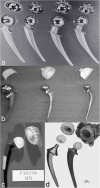Recent updates for biomaterials used in total hip arthroplasty
- PMID: 30534414
- PMCID: PMC6280401
- DOI: 10.1186/s40824-018-0144-8
Recent updates for biomaterials used in total hip arthroplasty
Abstract
Background: Total hip arthroplasty (THA) is probably one of the most successful surgical interventions performed in medicine. Through the revolution of hip arthroplasty by principles of low friction arthroplasty was introduced by Sir John Charnley in 1960s. Thereafter, new bearing materials, fixation methods, and new designs has been improved. The main concern regarding failure of THA has been the biological response to particulate polyethylene debris generated by conventional metal on polyethylene bearing surfaces leading to osteolysis and aseptic loosening of the prosthesis. To resolve these problems, the materials of the modern THA were developed since then.
Methods: A literature search strategy was conducted using various search terms in PUBMED. The highest quality articles that met the inclusion criteria and best answered the topics of focus of this review were selected. Key search terms included 'total hip arthroplasty', 'biomaterials', 'stainless steel', 'cobalt-chromium', 'titanium', 'polyethylene', and 'ceramic'.
Results: The initial search retrieved 6921 articles. Thirty-two articles were selected and used in the review.
Conclusion: This article introduces biomaterials used in THA and discusses various bearing materials in currentclinical use in THA as well as the newer biomaterials which may even further decrease wear and improve THA survivorship.
Keywords: Arthroplasty; Biomaterials; Ceramic; Cobalt-chromium alloy; Hip; Polyethylene; Stainless steel; Titanium alloy.
Conflict of interest statement
Not applicable.Not applicable.The authors declare that they have no competing interests.Springer Nature remains neutral with regard to jurisdictional claims in published maps and institutional affiliations.
Figures





Similar articles
-
Bearing surfaces in hip replacement - Evolution and likely future.Med J Armed Forces India. 2014 Oct;70(4):371-6. doi: 10.1016/j.mjafi.2014.04.015. Epub 2014 Aug 4. Med J Armed Forces India. 2014. PMID: 25382913 Free PMC article. Review.
-
Cemented total hip replacement cable debris and acetabular construct durability.J Bone Joint Surg Am. 2009 Jul;91(7):1664-70. doi: 10.2106/JBJS.G.00428. J Bone Joint Surg Am. 2009. PMID: 19571089 Free PMC article.
-
How has the introduction of new bearing surfaces altered the biological reactions to byproducts of wear and modularity?Clin Orthop Relat Res. 2014 Dec;472(12):3699-708. doi: 10.1007/s11999-014-3725-4. Clin Orthop Relat Res. 2014. PMID: 24942963 Free PMC article. Review.
-
Primary ceramic-on-ceramic total hip arthroplasty using a 32-mm ceramic head with a titanium-alloy sleeve.Clin Orthop Relat Res. 2015 Dec;473(12):3781-7. doi: 10.1007/s11999-015-4374-y. Clin Orthop Relat Res. 2015. PMID: 26024582 Free PMC article.
-
Bearing surfaces for total disc arthroplasty: metal-on-metal versus metal-on-polyethylene and other biomaterials.Spine J. 2012 Aug;12(8):693-701. doi: 10.1016/j.spinee.2011.05.008. Epub 2011 Jun 22. Spine J. 2012. PMID: 21700505 Review.
Cited by
-
Aluminum Nanoparticles Affect Human Platelet Function In Vitro.Int J Mol Sci. 2023 Jan 29;24(3):2547. doi: 10.3390/ijms24032547. Int J Mol Sci. 2023. PMID: 36768869 Free PMC article.
-
A Pilot Experiment to Measure the Initial Mechanical Stability of the Femoral Head Implant in a Cadaveric Model of Osteonecrosis of Femoral Head Involving up to 50% of the Remaining Femoral Head.Medicina (Kaunas). 2023 Mar 5;59(3):508. doi: 10.3390/medicina59030508. Medicina (Kaunas). 2023. PMID: 36984509 Free PMC article.
-
Cancer-Causing Effects of Orthopaedic Metal Implants in Total Hip Arthroplasty.Cancers (Basel). 2024 Mar 29;16(7):1339. doi: 10.3390/cancers16071339. Cancers (Basel). 2024. PMID: 38611017 Free PMC article.
-
Elevated Titanium Levels After Revision Total Hip Caused by Previously Unreported Mechanism.J Am Acad Orthop Surg Glob Res Rev. 2024 Aug 6;8(8):e24.00001. doi: 10.5435/JAAOSGlobal-D-24-00001. eCollection 2024 Aug 1. J Am Acad Orthop Surg Glob Res Rev. 2024. PMID: 39110769 Free PMC article.
-
Adverse Reaction to Zirconia in a Modern Total Hip Arthroplasty with Ceramic Head.Arthroplast Today. 2020 Jun 19;6(3):612-616.e1. doi: 10.1016/j.artd.2020.03.009. eCollection 2020 Sep. Arthroplast Today. 2020. PMID: 32995410 Free PMC article.
References
-
- National Joint Registry for England. Wales, Northern Ireland and the Isle of Man. 13th AnnualReport.http://www.njrcentre.org.uk/njrcentre/Portals/0/Documents/England/Report.... Accessed 2016.
-
- Kurtz S, Ong K, Lau E, Mowat F, Halpern M. Projections of primary and revision hip and kneearthroplasty in the United States from 2005 to 2030. J Bone Joint Surg Am. 2007;89:780–785. - PubMed
-
- Health Insurance Review & Assessment Service, Korea Healthcare Bigdata Hub. http://opendata.hira.or.kr/op/opc/olapDiagBhvInfo.do. Accessed 14 Sept 2018.
Publication types
LinkOut - more resources
Full Text Sources
Other Literature Sources
Miscellaneous

